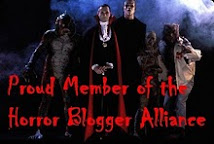And when I seriously start thinking about the horror of the '80s and my experience growing up in the genre, I tend to think about The Gate. I'm not sure how the old Christian ladies that ran our small town library ended up getting ahold of The Monster Squad and The Gate and making them available to children like Mikeself, but those little old ladies deserve a hug for bringing this one into my life.
The Gate might be the perfect horror movie for children. In a way, it even kind of follows the Disney formula for kids in peril. Parents go out of town, kids are left in charge with mischievous friends, trouble arrives quickly. It's like The Lion King with a bunch of clay monsters. And no Lions or singing. OK, there's some singing. But that's not the point. The point is that it's a movie about kids facing their fears, which is what Disney does all the damn time.
The Gate isn't about lions or mermaids or any of that boring Disney stuff, thankfully. It's about a hole in the backyard that has weird geodes (aka those rocks you crack open that look pretty inside) in it and also is a gateway to some kind of hell that's full of little angry monsters and unleashes a lot of other weird stuff too. That "weird stuff" takes on all kinds of forms throughout the film, and it seems that most of them - aside from the mini goblins - are the kinds of weird stuff that many kids would have nightmares about.
After all, what kid isn't afraid of whatever is living under their bed? I know I was, and I'm willing to bet you were too. And that's just part of The Gate's weirdness. Other scenes that seem to have been designed to destroy a child's ability to sleep at night involve a dead body coming out of a wall, a badly killed dog, and - in true kid manipulation form - parents turning evil. That last one is still one of the few moments in horror that really gives me the willies; a scene that - thanks to some great sound effects - has stuck in my mind for at least 20 years.
It's a testament to director Tibor Takacs - whose I, Madman is another kinda surreal, kinda creepy, kinda awesome '80s horror movie (that's not for kids) that's been chosen for MMOTW - that The Gate manages to pack so many surprises into 85 minutes. And it's more impressive that the chills still work on me as full grown adult. Sure, the film is as dated as any '80s offering, but the effects still meet the story's needs very well. (I must also mention that the film is helped out today by a shockingly good DVD transfer by Lionsgate, which is seriously one of the best looking restorations I've seen on the format. I had the old bargain full-frame DVD before this one, and the improvements that Lionsgate were able to make are nothing short of amazing. It's one of the best '80s horror DVDs out there.)
I'm sure there are viewers out there who haven't seen The Gate yet and who might struggle with its combination of clay monsters and young Stephen Dorff, who already had brooding and squinting down at a young age. But I really don't think it's just nostalgia that has me loving The Gate today. Takacs' film is still a bold and ambitious horror film, with effects scenes - including a fantastic sequence when one of the kids slips into the deadly hole and the final confrontation with a creature from the pit - that would make most horror films jealous. There's a balance between the scares and the action that keeps the viewer involved in the film, and they should be interested in The Gate's tale of terror even if they're not always scared by it.
And, as I already said, I think The Gate's scares will work best on the kids. An early PG-13 horror film (once again debunking the myth that all effective horror films HAVE to be rated R), The Gate might be a perfect starting point for the youngster who's interested in scary stories or monsters and ghosts. It's got just the right mix of scares and action, meaning the kids will not only experience the fear that they desire, but will also witness kids empowering themselves to deal with those fears.
A lot of horror films aren't right for children, often because most kids want to see the spooky stuff but don't have a plan for how they'll not cry themselves to sleep later. The Gate, on the other hand, is a movie that supports the brave kids. Like other empowered kids films - films like '80s classic The Goonies and recent hit Super 8 - The Gate doesn't sell young folks short. If you're gonna give into your kid's demand for "scary movies", you might as well start with one that reminds them they have power over their fears - and The Gate does that. And if you're a kid at heart who's looking for a fun '80s horror film, then The Gate is for you too.






























































